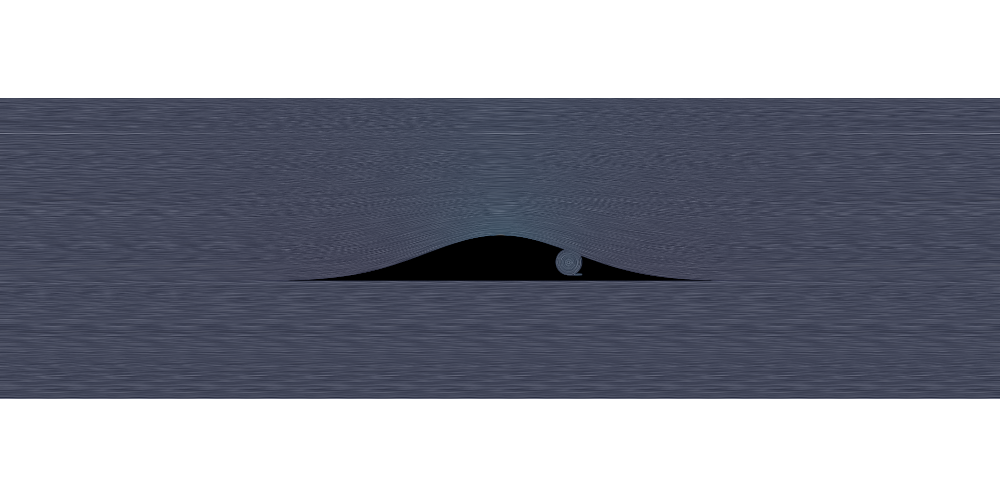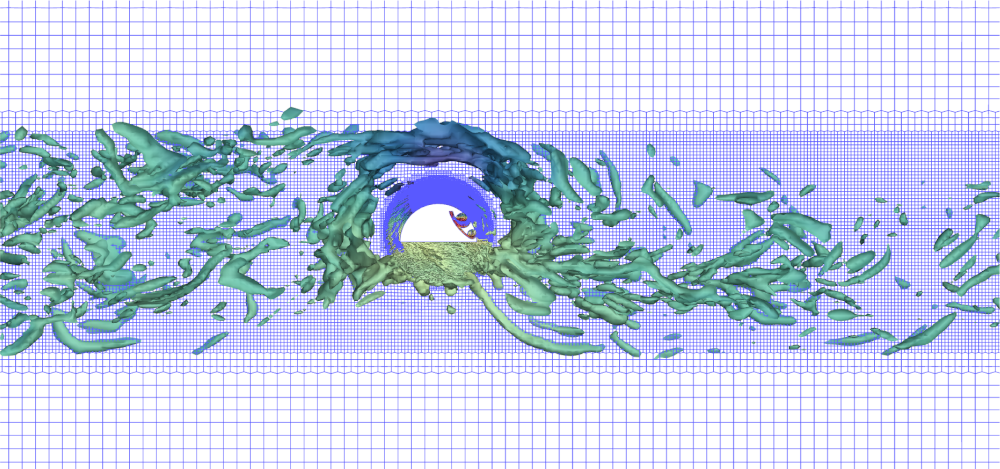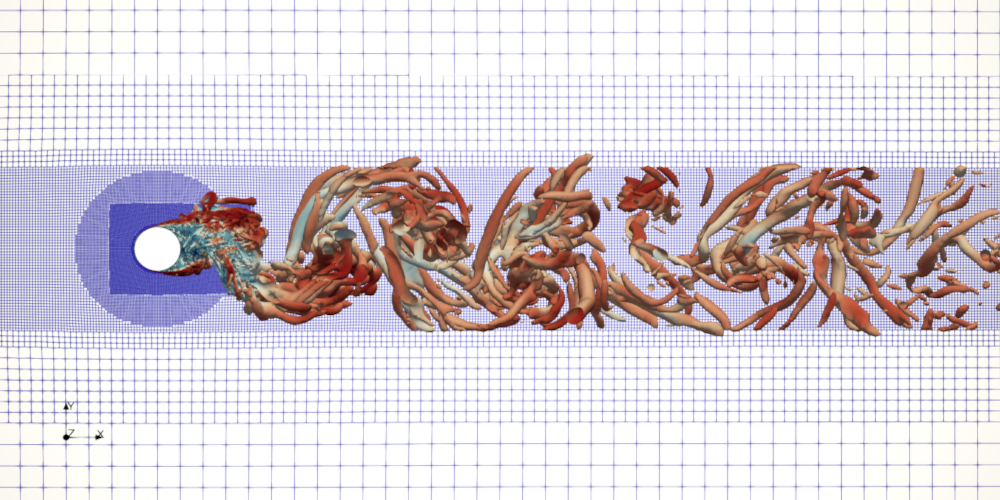Support Project on Patreon or Boosty!
We are dedicated to bringing this really innovative and impactful project to life. Your support on Patreon or Boosty can make a huge difference in helping us achieve our goals. By becoming a patron, you’ll get exclusive access to the project' data. Visit Our Patreon or Boosty Page and make a pledge!
Thank you for your support! Together, we can make this project a success!
Advancing Active Flow Control Technologies for Bluff-Body Aerodynamics
Goals & Objectives
The prime research aspects of the present project is R&D for:
• Small and medium scale unmanned aerial and autonomous underwater vehicles (UAVs and AUVs);
• Active and passive control systems of the bluff-body wake dynamics and the vortex shedding suppression;
• Machine learning algorithms for flow control.
The parallel goal is further development of the computational numerical algorithms, methods and tools (Numerical platform) to investigate the highlighted aspects.

@2025 On-going R&D
Plan for 2025: Subsonic and transonic flows around different types of bluff-bodies: compressible and viscous effects on the active flow control system based on the trapped vortex cells.

@2025 On Numerical Simulations of Turbulent Flows over a Bluff Body with Aerodynamic Flow Control Based on Trapped Vortex Cells: Viscous Effects
I'm thrilled to share that my latest manuscript has been published in Fluids! This work marks a significant milestone in the development of an aerodynamic flow control system based on trapped vortex cells, enabling ultra-high lift for thick airfoils.

@2024 Large-eddy simulation of the flow past a circular cylinder at Re = 130,000
I'm happy to announce my new manuscript was published in Fluids. Here are some highlights: LES of the flow over a circular cylinder at Re = 130,000 using Ansys Fluent and OpenFOAM and different floating point precision. Comparison of single- and double-precision solvers in Ansys Fluent revealed no significant discrepancies. Also simulations show that single-precision results stable by Lyapunov, with no loss of accuracy.

@2023 Free stream turbulence intensity effects on the flow over a circular cylinder at Re=3900: bifurcation, attractors and Lyapunov metric
I'm proud to announce that my recent research published in Ocean Engineering. This manuscript "Free stream turbulence intensity effects on the flow over a circular cylinder at Re=3900: bifurcation, attractors and Lyapunov metric" advances my previous study (Flow, Turbulence and Combustion, 2012) using the Lyapunov stability theory and several aspects from the nonlinear dynamical systems.
@2023 Active flow control of the turbulent flow over a bluff-body with the integrated trapped vortex cells
I’m happy to announce that my latest manuscript was published in Ocean Engineering. This is pioneering research on the turbulent flow over a bluff-body with active flow control, based on the trapped vortex cells, conducted by using high-fidelity eddy-resolving simulations.
Large-eddy simulations of the flow past a bluff-body with active flow
control based on trapped vortex cells at Re = 50000,
Ocean Engineering 280 (2023) 114496
@2022 HTC effects: wake dynamics and vortex shedding suppression
2D URANS of the turbulent flow over a semicircular cylinder at Re = 100,000 and M = 0.12 show possibility to establish flow control of the wake dynamics and vortex shedding suppression by varying heat transfer effects. The results indicate that by increasing a temperature difference between a surface of the obstacle and free-stream: a) a Strouhal number decreases linearly accompanied by the the expansion of the recirculation zone length; b) the total drag coefficient growths monotonically while the lift coefficient decreases.
@2022 My first book
Вышла моя первая книга, как обобщение более десятилетнего опыта работы с пакетом OpenFOAM® и моделирования крупных вихрей: «Моделирование крупных вихрей для задач аэродинамики плохообтекаемых тел на основе технологии OpenFOAM®»

@2021 Turbulent flow over a triangular cylinder at moderate Re = 45000
Assessment of algebraic subgrid scale models for the flow over a triangular cylinder at Re = 45000,
Ocean Engineering (2021)
DOI: 10.1016/j.oceaneng.2020.108559
@2021 Turbulent flow over a semi-circular cylinders at moderate Re = 50000
Large-eddy simulations of the flow over a semi-circular
cylinder at Re = 50000, Computers & Fluids (2021)
DOI: 10.1016/j.compfluid.2021.105054
@2018 Active flow control: a fixedWing concept (preliminary)
This video shows the Large-eddy simulation of the flow over a fixed-wing UAV concept with the integrated active flow control (AFC) system. The simulation was performed using OpenFOAM. The flow regime is characterized by the Reynolds number, Re = 140000, Mach number, M = 0.1 and zero angle of attack. Visualization is based on the Q-criterion.
@2018 Active flow control: 3D LES (preliminary)
This video demonstrates the basis (preliminary) of the Active Flow Control (AFC) implemented to a simple bluff-body. The flow regime is: Re=140000, M=0.1, zero angle of attack. CFD demonstrates that the massive recirculation zone is mostly vanishing for the vehicle with AFC. The visualization of the coherent flow structures demonstrates that the AFV concept keeps only the low scale turbulence and moves away from the massive recirculation zone.
@2018 Active flow control: 2D URANS (preliminary)
Turbulent flow over a semi-circular cylinder at a diameter-based Reynolds number Re = 140000 and Mach number Ma = 0.25 and zero angle of attack: the developed active flow (AFC) control system based on the three trapped vortex cells demonstrates about non-separated flow past the bluff-body. The massive detached separated zone over the semi-circular cylinder has mostly vanished due to AFC. The predicted aerodynamic quality (the ratio of the lift to drag coefficients) for this flow is about 25, which allows to achieve at least theoretically an ultimate high lift performance of the bluff-body with AFC.
@2017 Turbulent combustion flow over a bluff-body (Volvo test rig)
• Reynolds-Averaged, Scale-Adaptive and Large-Eddy
Simulations of Premixed Bluff-Body Combustion Using
the Eddy Dissipation Concept,
Flow, Turbulence and Combustion (2017)
DOI: 10.1007/s10494-017-9880-4
@2014 Towards simulation of far-field aerodynamic sound from a circular cylinder
• Lysenko, D.A., Ertesvåg, I.S., Rian, K.E., Towards simulation of far-field aerodynamic sound from a circular cylinder using OpenFOAM, I J Aeroacoustics, 13(1), 141 – 168 (2014)
@2012-2014 Turbulent flow over a circular cylinder at Re = 3900 and Re = 20000
• Lysenko, D.A., Ertesvåg, I.S., Rian, K.E., Large-eddy simulation of the flow over a circular
cylinder at Reynolds number 2×104, Flow Turbulence Combust, 92, 673-698 (2014)
• Lysenko, D.A., Ertesvåg, I.S., Rian, K.E., Large-eddy simulation of the flow over a circular
cylinder at Reynolds number 3900 using the OpenFOAM toolbox, Flow Turbulence
Combust, 89 491-518 (2012)
@2005-2009: VortexCell2050
• Isaev, Aerodynamics of thickened bodies with vortex vells (numerical and physical modeling)(In Russian),
St.Petersburg Polytechnic University, Saint-Petersburg (2016)
• Sedda et al., Trapped vortex cell for aeronautical applications: flow analysis through
PIV and Wavelet transform tools, in: 10th Pacific Symposium on Flow Visualization and Image Processing, Naples, Italy (2015)
• The 6th framework EU project VortexCell2050

@2009: Turbulent flow around a surface mounted cube placed in a channel
Results of numerical simulation of the turbulent flow around a surface mounted cube placed in a channel
(Re = 40,000) within the conventional URANS
approach and the Spalart-Allmaras turbulence model are presented.
• Lysenko, D.A. and Isaev, S.A., Calculation of unsteady flow past a cube on the wall of a
narrow channel using URANS and the Spalart-Allmaras turbulence model,
J Eng Physics Thermophysics, 82(3) 488-495 (2009)
@2001-2006: Plane laminar/turbulent flows over a circular cylinder
• Isaev et al., Comparative
analysis of the calculation data on an unsteady flow around a circular cylinder obtained
using the VP2/3 and FLUENT packages and the Spalart–Allmaras and Menter turbulence
models, J Eng Physics Thermophysics, 78(6), 1199-1213 (2005)
• Isaev et al., Numerical
simulation of unsteady-state heat transfer under conditions of laminar transverse flow past a
circular cylinder, High Temperature. 43(5), 746-759 (2005)
@2001-2006: Plane laminar/turbulent flows in a square cavity
• Isaev et al., Complex
analysis of turbulence models, algorithms, and grid structures at the computation of
recirculating flow in a cavity by means of VP2/3 and FLUENT packages.
Part 2. Estimation of models adequacy, Thermophysics and Aeromechanics, 13(1), 55-65 (2006)
Part 1. Scheme factors influence, Thermophysics and Aeromechanics, 12(4), 549-569 (2005)
• Isaev et al., Simulation of
a circulation laminar flow around a square cavity with a mobile boundary at high Reynolds
numbers with the use of VP2/3 and the FLUENT packages, J Engineering Physics and
Thermophysics, 78(4), 799-816 (2005)
@1994-2001: The EKIP project
• Isaev, Flow control past bodies with vortex cells applied to the blended wing body aircraft
(numerical and physical modeling) (In Russian), Moscow, St-Petersburg (2001)
• The first, pioneering flying UAV prototype EKIP (1994-1995)
• Savitsky et al. Method for controlling boundary layer on an aerodynamic surface of a flying vehicle, US Patent No. 5417391 (1995)
• Kasper, Aircraft wing with vortex generation, US Patent No. 3831885 (1974)
• Ringleb, Separation control by trapped vortices. in: Boundary layer
and flow control, Ed. Lachmann G.V., Pergamon Press (1961)
